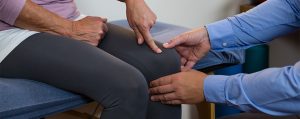Dancer’s Hip: How to Stop the Snapping
A feeling of popping or snapping in the hip with certain movements is a very common complaint, especially among young athletes. Consistent snapping or popping with pain is a clinical sign of snapping hip syndrome, otherwise known as “dancer’s,” hip. This condition is often seen in athletes who play high-mobility sports but is more prevalent among gymnasts, cheerleaders, and dancers, specifically ballet dancers. Three types of hip snapping that occur include external, internal, and intra-articular. Below are tips to lessen the severity of pain and strategies to prevent the occurrence altogether.
The Road to Recovery: From ACL Tear to the Joffrey Ballet
ACL injuries are often talked about in contact sports, but ballet dancers are also at risk of a tear. Jumping is the most common mechanism of injury for a ballet dancer to tear their ACL. Max Dawe, of the Joffrey Ballet, learned this firsthand last summer. I had the pleasure of being Max’s Physical Therapist in the later stages of his rehab while Alyssa Hartley, PT, DPT, OCS worked with him during the first eight months. Recovering from an ACL reconstruction is a long and intense process focused on regaining strength, range of motion, neuromuscular control, and progression of agility and plyometrics tailored to specific sport demands. The general recommended timeline to return to sport is at least nine months due to the high risk of re-injury returning at the previously thought six months. I interviewed Max asking about his recovery process, and we are happy to share his experiences.
6 Tips For Practicing Safe Stretching In Dance And Gymnastics
Dance and gymnastics are two sports that require an extreme amount of mobility and flexibility, as well as strength, power, and endurance to be successful. Mobility is different from flexibility and flexibility is not an indicator of good mobility. Flexibility is defined as the muscles’ ability to stretch temporarily. An example of flexibility would be a rubber band; it can temporarily lengthen but returns to a normal resting rate. Mobility is a joint’s ability to actively move through a specific range of motion. To simplify this explanation of flexibility versus mobility, flexibility is related to muscle length and mobility is related to a joint’s ability to move.
Preparing for The Nutcracker
Co-authors: Katie Warner PT, DPT, OCS and Evan Boersma of The Joffrey Ballet
December is a magical time of year in Chicago, with plenty of festive things to do to enjoy the winter holiday season. The Joffrey Ballet puts on an impressive run of The Nutcracker this year, featuring 25 full-length performances from December 3rd to the 27th. There are additionally two abbreviated performances for local schools. “Joffrey’s beloved version of The Nutcracker takes inspiration from the 1893 World’s Fair, one of the city’s great historical attractions of the late 19th century.” Athletico is proud to be the Official Provider of Physical Therapy for The Joffrey Ballet. In anticipation of this season’s production, we wanted to spotlight the preparation that goes into it from the perspective of company dancer Evan Boersma and myself, one of the physical therapists.
Jacqueline Burnett of Hubbard Street Dance Chicago: Back on Stage with ‘Re/Turn’
Author: Jacqueline Burnett, Dancer, Hubbard Street Dance Chicago
I left behind my “performance-ready” body two hours before Hubbard Street Dance Chicago’s opening night at the Harris Theater on March 12th, 2020. We had completed technical rehearsal, and I was about to see Madeline G., Athletico Performing Arts Physical Therapist, who was waiting for dancers needing one last moment of help before lifting the curtain for an extremely physical evening of dance. Just then, our directors came to the stage and announced the show would be cancelled due to a city-wide response to Covid-19. The following 20 months turned into a completely different lifestyle, and now Hubbard Street has finally returned to the theater this past weekend with a live theater audience.
Common Hip Injuries in Dancers
Hip injuries in dancers comprise about 17.2% of all muscular and bony injuries. These injuries are often hard to diagnose because many have overlapping signs and symptoms. Injuries can occur for a variety of reasons. Some injuries are traumatic from a fall, contact, or another impact like a fracture or an avulsion (where a muscle can yank on its bony attachment and pull some bone loose). Additional injuries can come from overuse and result in tendinitis (or other tendinopathies), bursitis, snapping hip, strain, or a labral tear. Some are bony, like Femoral Acetabular Impingement (FAI) or dysplasia. Whatever the cause, a hip injury can be frustrating for a dancer.
4 Common Ankle Injuries in Dancers
In any sport or activity that puts demands on the body, injuries can occur, and dance is no different. Some of the most common injuries seen in physical therapy clinics in regards to dancers, are injuries related to the foot and ankle. The following information serves to help educate dancers on some of the more common ankle injuries, along with techniques that could be applied to help minimize the risk of these injuries. It is important to note that only a licensed medical professional can diagnose an ankle injury.
5 Cardiovascular Fitness Considerations for Dancers
Dancers’ leaps, turns, and lifts can seemingly defy laws of physics. In order to jump higher and turn faster, dancers must implement cross-training for strength and endurance. Dancers from around the world have faced new challenges practicing at home due to the COVID-19 pandemic. Now, more than ever, it is important for dancers to pursue physical fitness outside of traditional dance class to ultimately improve their technical abilities for when they hit the stage in the future.
